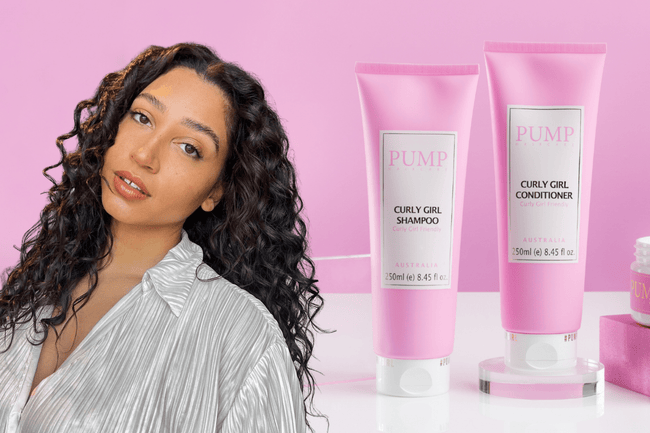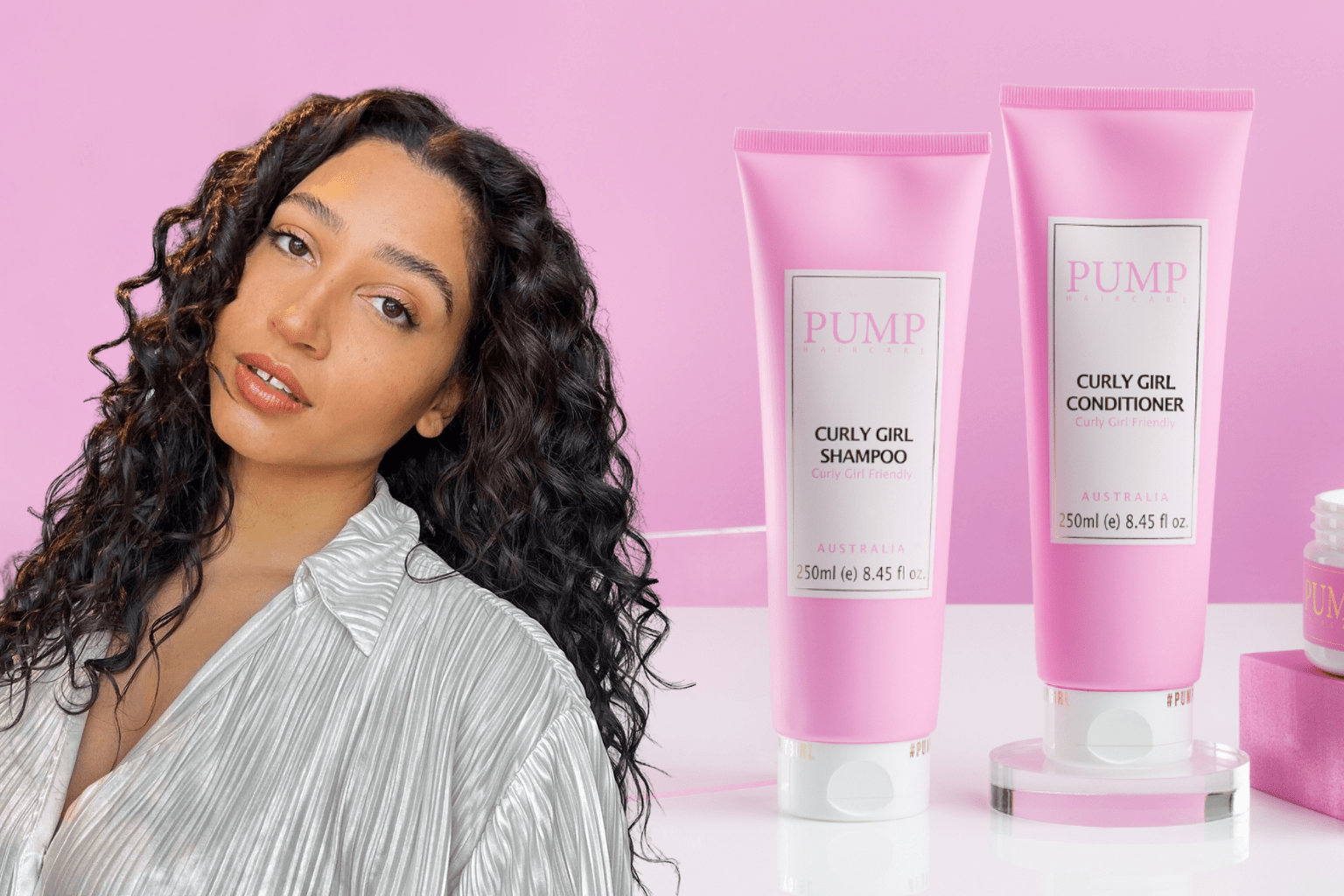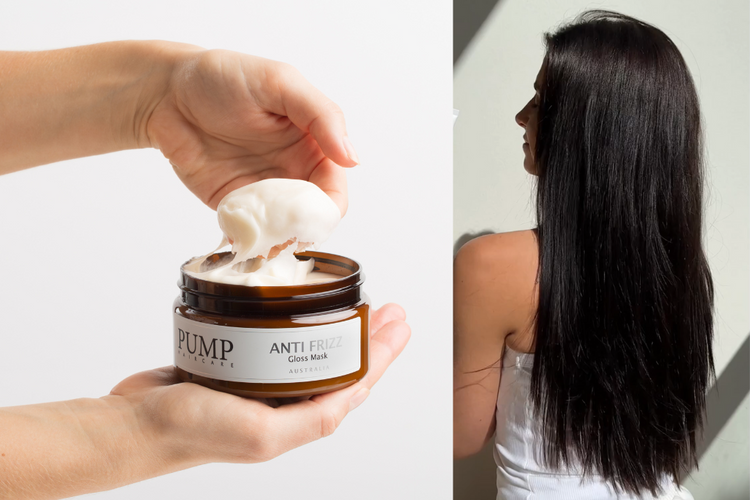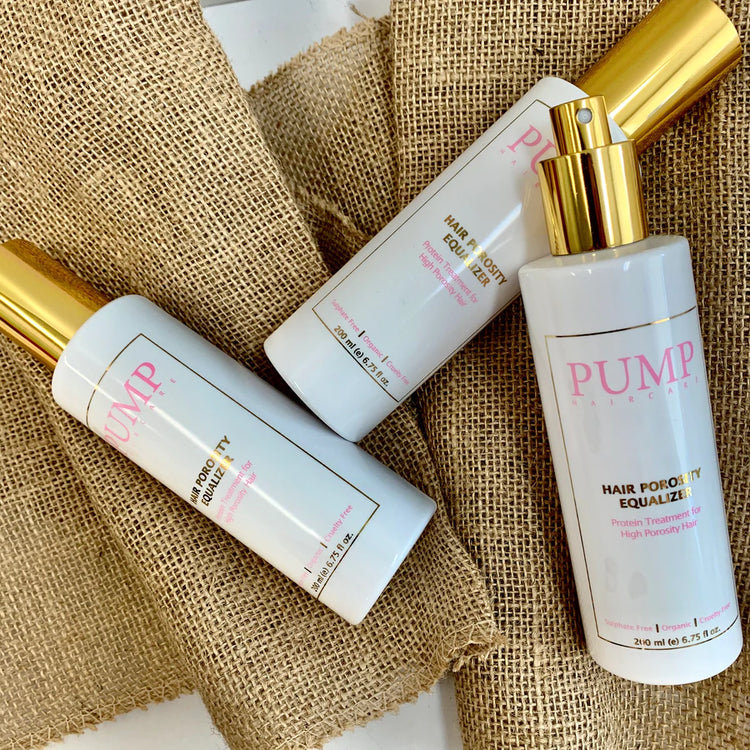For all the curly-haired individuals out there who find themselves in a constant battle with frizz and are looking to enhance their natural curl pattern, you’re not alone. Managing curly hair can feel like an uphill battle, but with the right hair wash routine, you can achieve the results you desire. We understand that the struggle is real, and that is why we are here to provide you with expert advice on how to wash curly hair and keep your luscious locks looking refreshed and vibrant as ever:
What shampoo should you use to wash curly hair
The key things you want to look out for when choosing a shampoo for your curls is one that is sulphate-free and doesn't contain drying ingredients. The gentler and more natural ingredients the better, as curly hair is prone to dryness as the oils from your scalp struggle to travel down the hair shaft. Look for ones that contain moisture-boosting ingredients such as Pumps Curly Girl Shampoo, which contains hydrolysed rice protein and argan oil.
Step-by-step instructions on how to wash curly hair
When it comes to washing your natural curls, establishing a well-structured curly hair wash routine is crucial to maintaining your moisture levels, minimising breakage and keeping your curls looking their best. Here are our seven-step recommendations:
Step 1: Detangle gently
Using a wide-toothed comb or your fingers, gently detangle your hair starting from the base and working your way to the roots. You can also use a curl hair oil as a pre-wash treatment to help remove any knots or tangles without the risk of breakage whilst giving your hair that extra nutrient boost. It can be left in your hair for 30 minutes prior to washing as a conditioning treatment or overnight for a deeper treatment.
Step 2: Wet your hair thoroughly
Use cold to lukewarm water to wet your hair thoroughly to ensure your hair isn’t drying out from hot water.
Step 3: Apply sulphate-free shampoo
Use a small amount of sulphate-free, curly girl-friendly shampoo and massage it gently into your scalp, letting the excess shampoo distribute down the length of the hair shaft. You can also use a shampoo brush to gently lift any product buildup on the scalp. If you are using the co-washing method of using conditioner to clean your hair instead of shampoo, skip steps 3 and 4.
Step 4: Rinse thoroughly
Use cold to lukewarm water and rinse your hair thoroughly, making sure any product has been completely washed out.
Step 5: Removing excess water before applying conditioner
Because water acts as a barrier, the conditioner isn't going to be able to deeply penetrate the hair shaft if it is heavily waterlogged. We recommend gently squeezing excess water from your hair before applying conditioner. This will enhance the absorption of conditioner into your hair, improve product distribution and use less product, making your conditioner last longer.
Step 6: Apply conditioner
Begin by applying conditioner from the ends of your hair, delicately working it up the hair shaft. After evenly massaging the product throughout your hair, you can use a wide-toothed comb to distribute the product evenly. When choosing a conditioner for your curly hair, it is important to choose one that is free from any drying and harsh ingredients. Opting instead for ones with natural oils and ingredients such as shea butter or argan oil to hydrate your curls. We recommend Pump’s Curly Girl Conditioner for its deep conditioning properties, giving your hair the protection and hydration it needs.
Step 7: Rinse thoroughly and dry
Using cold to lukewarm water, rinse your hair thoroughly and make sure any product has been completely washed out. You can gently remove any excess water with the plopping technique. To do the plopping technique, throw your hair forward and use a microfiber towel or soft cotton t-shirt to gently squeeze your curls in an upward motion until you have removed most of the water. You can then add in a curl cream or gel and continue to plop upwards, leaving the rest to air dry or use a diffuser on a cool to medium heat setting to get an enhanced curl shape.
How often should you wash your curly hair?
How often you wash your hair depends on your hair texture and how much natural oil you produce. However, as a general rule of thumb, washing your hair 1-2 times a week is a good place to start.
What to avoid when washing curly hair?
When it comes to curly hair, there are a number of practices you want to avoid to ensure your hair's natural curl pattern stays intact. Here are a number of things to avoid when washing curly hair:
Washing hair too often
Although your hair might feel greasy and oily after a couple of days, try to resist the temptation of washing your hair too frequently. Instead, try using a refresher spray or dry shampoo in between washes to give your hair time to naturally regulate itself.

Washing hair too roughly
Any harsh rubbing or scrubbing can cause damage and frizz to the hair follicles. It is always best to use gentle circular motions to massage shampoo into your scalp and use your fingers to gently detangle your curls with conditioner.
Rough towel drying
Avoid roughly towel drying your hair by opting instead for a microfiber towel or soft cotton t-shirt to gently plop your hair upwards to remove any excess water and refine your natural curl pattern.
Using the wrong products
Certain products may not be suitable for the Curly Girl Method, so it is essential to thoroughly research any curly hair products you are considering using. Steer clear of those containing drying alcohols or silicones, as they can lead to product buildup and disrupt your curl pattern. Instead, seek out products enriched with natural oils that have been specifically formulated to enhance your natural curl pattern.
Pilling hair on top of the head
When shampooing or conditioning your hair, avoid piling your hair on top of your head as this can cause tangles and knots to form. Instead, adopt a gentler approach by evenly distributing the product through your hair. Concentrating on your scalp while shampooing and focusing on the tips when applying conditioner.
Tight Hairstyles After Washing
After washing your hair should be left to air dry or gently diffused on a cool to medium heat setting. If you put your curls into braids or ponytails after washing, it can create tension, causing your curls to lose their shape.
Common FAQs about washing curly hair
Here are the answers to some common questions about washing curly hair:
Is it better to let curly hair air dry?
If you have the time and patience it is always best to let your hair air dry. This is because there is no added heat, meaning it will reduce frizz and help your curls maintain their natural curl pattern. If you don’t have the time for air drying, use a diffuser on a cool setting. Cold drying with a diffuser is a great option for curly hair because it minimises heat damage, enhances curl definition, and reduces frizz while adding volume. It's a gentle and effective way to achieve beautiful, well-defined curls.
Is it OK to wet curly hair every day?
Wetting your hair every day can lead to over-drying the hair follicles, leading to potential breakage. If you want to style your curls, try using a spray bottle with water or a curl refresher to enhance your curls between wash days.
Is it good to brush wet curly hair?
Brushing your hair wet can cause your natural curl pattern to be interrupted and break. It is best to gently brush your hair before washing and use a wide-toothed comb (or your fingers) to distribute conditioner through your hair.
Is too much conditioner bad for curly hair?
Yes, product buildup can lead to scalp issues and cause your hair to look greasy and weighed down. Use the recommended amount and focus on the tips of your hair to avoid product buildup on the scalp. Whenever introducing a new product into your curly hair routine, give your hair a week to adjust to see how it reacts to the product. If you find your hair is drying out too much between washes, you can always incorporate co-washing into your routine.
Should I wash my curly hair every day?
Absolutely not! No matter your hair texture, washing your hair every day doesn’t give your hair and natural sebum production time to do its thing. With curly hair, once to twice a week max is the way to go.
When is the best time to wash curly hair?
While there isn't a “wrong” time to wash your hair and you should decide on a routine that works best for you, there are a number of advantages to washing your hair in the morning:
Refreshed Look and Easier Styling
Washing your hair in the morning gives you the ample time to refresh and style your hair the way you want it. Whether you choose to air dry your hair or diffuse it, you will be able to style your hair the way you want without risking it getting messed up in your sleep. If you do decide to wash your hair before bed, try wearing a silk or satin hair wrap or sleeping on a silk pillowcase to remove any friction.
Scalp Health
Washing your hair in the morning can help prevent product buildup from accumulating on your scalp, keeping your scalp fresh and healthy.
Removal of Nighttime Products
Washing your hair in the morning also gives you the opportunity to wash out any hair masks or leave-in treatments you put in the night before.





